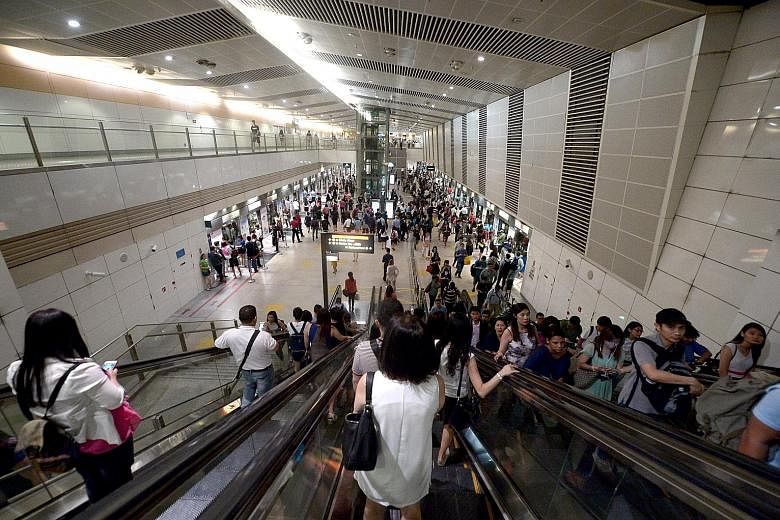There has been about one incident a day involving escalators here over the last two months, and "user behaviour" was behind most of them.
The Building and Construction Authority (BCA) said yesterday that based on its investigations, the most common cause of escalator incidents was users carrying heavy or bulky objects and losing their balance. Other causes included inattentiveness, and leaning against the side of the escalator, it said.
There are more than 6,000 escalators in Singapore.
Only three of the 63 cases which occurred over the last two months resulted from mechanical faults, such as a handrail stopping while the escalator was still in operation.
Mr Ameerali Abdeali, president of the National Safety Council of Singapore, said the figure was not acceptable.
-
No wear and tear from walking
-
Despite some claims, walking up and down escalators is unlikely to damage them.
Last week, a letter to The Straits Times Forum said people should not "overburden" escalators by walking on them, and suggested this was behind frequent breakdowns.
The letter was shared more than 9,000 times on Facebook and sparked a debate.
A 2013 article in trade publication Elevator World was even cited, which said having passengers stand on one side of escalators and allowing them to walk on the other would result in the escalator's chains being unevenly worn out.
But experts say this is unlikely. "An escalator is just like a travelator, except that one is on an incline. If you can walk on a travelator, why not an escalator?" said engineer Dominic Cher, 49.
Mr Cher, an authorised examiner for lifts and escalators, said regularly reversing the direction of an escalator could help address uneven damage. "It's like rotating tyres on a car."
The Building and Construction Authority (BCA) told The Straits Times that regular maintenance and replacement of parts could help address wear and tear. Owners have to engage registered service contractors to maintain the escalators at least once a month.
Lift and escalator engineer Kok Peng Koon said the main concern with walking on escalators was not damage to the machines, but safety. "For their own safety, people should just stand on the steps and hold on to the handrail."
The debate also called into question the keep-left policy here. SMRT first began encouraging commuters to keep to the left of escalators in stations in 2002, to clear a passage for those in a hurry. Mr Cher does not think standing on one side will cause uneven wear and tear.
BCA said the etiquette of keeping left decreases the chance of rushing passengers knocking into other users or falling. "As such, we advise all users to practise safe use of escalators for their own personal safety and exercise consideration for others while on the escalator."
Zhaki Abdullah
"Much more needs to be done," he said. For example, signs reminding users to be more careful could be placed at escalators.
The most vulnerable are older riders - 78 per cent of the incidents involved those above the age of 60. Retiree Lim Chwee Leong, 64, is still in a coma after falling down an escalator at Bishan MRT station last month.
Children make up another vulnerable group, said Mr Ameerali, noting that parents are responsible for ensuring their children do not run or play on escalators.
-
63
Number of escalator incidents here since Nov 1
3
Number of cases which involved mechanical faults
The Land Transport Authority (LTA), together with rail operators SMRT and SBS Transit, is currently trying out reduced escalator speeds at some MRT stations that are frequently used by the elderly and children. These include Kent Ridge, Pioneer and Chinatown stations.
LTA figures showed there were 0.15 escalator incidents per one million riders at MRT stations between January and May this year.
New regulations introduced last month require escalator owners to apply for operating permits, and report incidents to the BCA.
The BCA is also working with shopping malls and train operators to disseminate posters with escalator safety tips. These include holding on to handrails and encouraging those with trolleys or luggage to use the lifts instead.
"As most of the reported escalator incidents could have been prevented, we need to raise the level of awareness on the safe use of escalators," said BCA chief John Keung.
Escalators are a major cause of injuries worldwide, with about 10,000 serious injuries occurring annually in the US alone.
The South China Morning Post reported 382 accidents on the escalators in Hong Kong's mass transit railway stations in the first seven months of last year.


